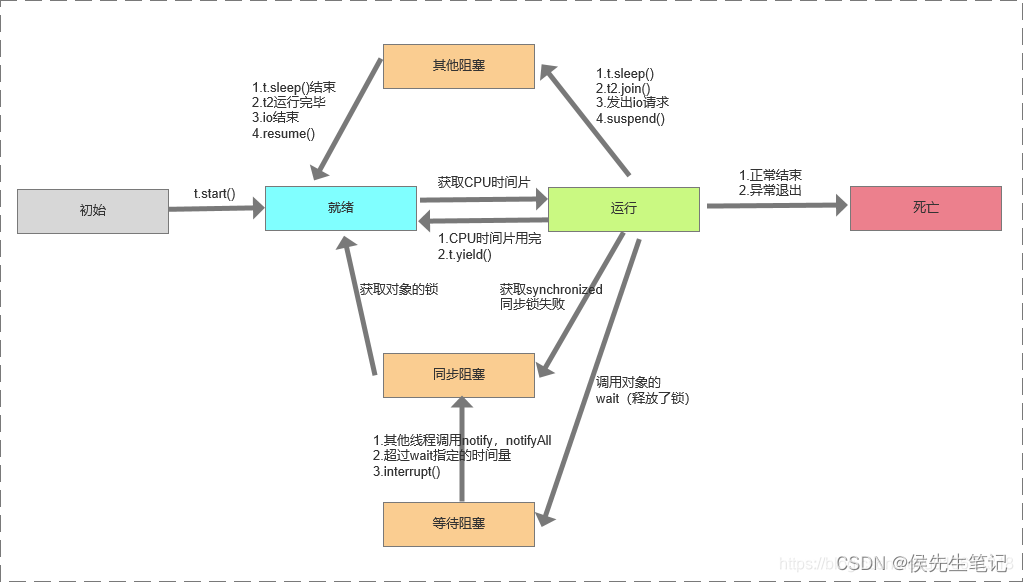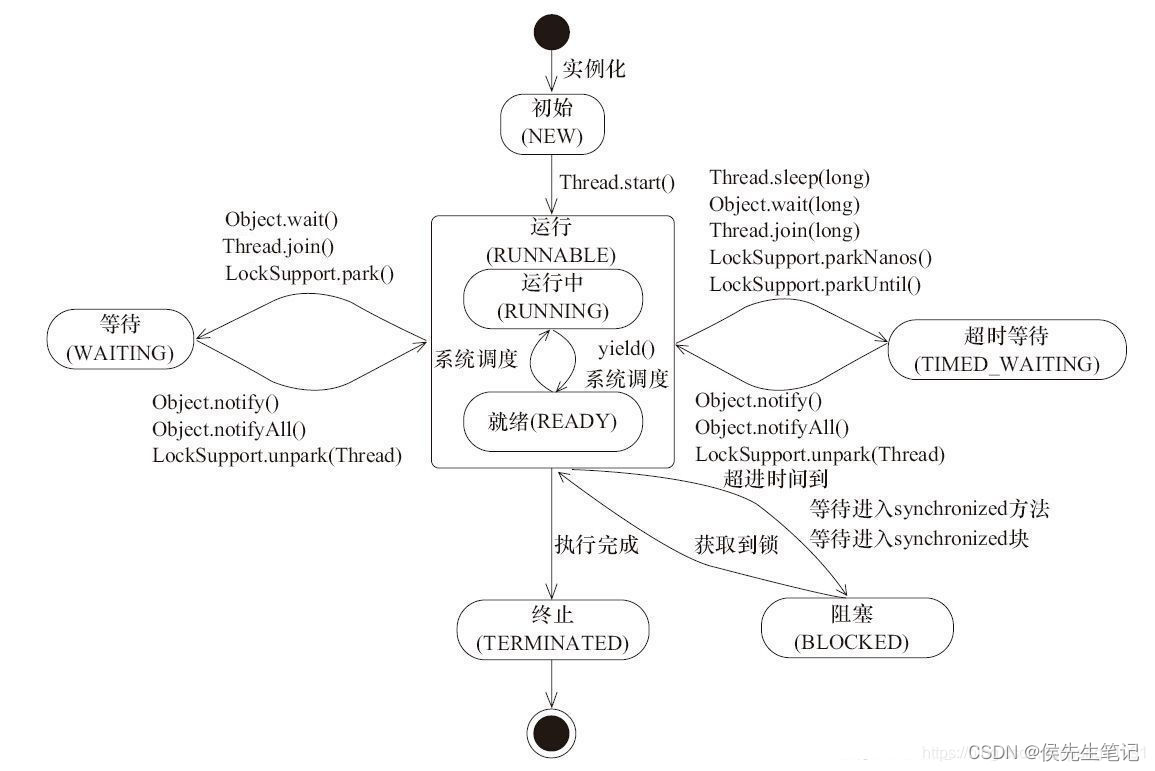线程状态
操作系统层面线程五种状态

- 初始状态,仅仅是在语言层面上创建了线程对象,即Thead thread = new Thead();,还未与操作系统线程关联
- 可运行状态,也称就绪状态,指该线程已经被创建,与操作系统相关联,等待cpu给它分配时间片就可运行
- 运行状态,指线程获取了CPU时间片,正在运行当CPU时间片用完,线程会转换至【可运行状态】,等待 CPU再次分配时间片,会导致我们前面讲到的上下文切换。就绪状态是进入到运行状态的唯一入口
- 阻塞状态
- 如果调用了阻塞API,如BIO读写文件,那么线程实际上不会用到CPU,不会分配CPU时间片,会导致上下文切换,进入【阻塞状态】
- 等待BIO操作完毕,会由操作系统唤醒阻塞的线程,转换至【可运行状态】
- 与【可运行状态】的区别是,只要操作系统一直不唤醒线程,调度器就一直不会考虑调度它们,CPU就一直不会分配时间片
- 终止状态,表示线程已经执行完毕,生命周期已经结束,不会再转换为其它状态。死亡的线程不可再次复生
Java API 层面线程六种状态

通过查看Thread类的State方法,我们可以看到Java线程其实是六种状态
public enum State {
/**
* Thread state for a thread which has not yet started.
*/
NEW,
/**
* Thread state for a runnable thread. A thread in the runnable
* state is executing in the Java virtual machine but it may
* be waiting for other resources from the operating system
* such as processor.
*/
RUNNABLE,
/**
* Thread state for a thread blocked waiting for a monitor lock.
* A thread in the blocked state is waiting for a monitor lock
* to enter a synchronized block/method or
* reenter a synchronized block/method after calling
* {@link Object#wait() Object.wait}.
*/
BLOCKED,
/**
* Thread state for a waiting thread.
* A thread is in the waiting state due to calling one of the
* following methods:
* <ul>
* <li>{@link Object#wait() Object.wait} with no timeout</li>
* <li>{@link #join() Thread.join} with no timeout</li>
* <li>{@link LockSupport#park() LockSupport.park}</li>
* </ul>
*
* <p>A thread in the waiting state is waiting for another thread to
* perform a particular action.
*
* For example, a thread that has called <tt>Object.wait()</tt>
* on an object is waiting for another thread to call
* <tt>Object.notify()</tt> or <tt>Object.notifyAll()</tt> on
* that object. A thread that has called <tt>Thread.join()</tt>
* is waiting for a specified thread to terminate.
*/
WAITING,
/**
* Thread state for a waiting thread with a specified waiting time.
* A thread is in the timed waiting state due to calling one of
* the following methods with a specified positive waiting time:
* <ul>
* <li>{@link #sleep Thread.sleep}</li>
* <li>{@link Object#wait(long) Object.wait} with timeout</li>
* <li>{@link #join(long) Thread.join} with timeout</li>
* <li>{@link LockSupport#parkNanos LockSupport.parkNanos}</li>
* <li>{@link LockSupport#parkUntil LockSupport.parkUntil}</li>
* </ul>
*/
TIMED_WAITING,
/**
* Thread state for a terminated thread.
* The thread has completed execution.
*/
TERMINATED;
}
- 初始(NEW):新创建了一个线程对象,但还没有调用start()方法。
- 运行(RUNNABLE):Java线程中将就绪(ready)和运行中(running)两种状态笼统的称为“运行”。线程对象创建后,其他线程(比如main线程)调用了该对象的start()方法。该状态的线程位于可运行线程池中,等待被线程调度选中,获取CPU的使用权,此时处于就绪状态(ready)。就绪状态的线程在获得CPU时间片后变为运行中状态(running)。
- 阻塞(BLOCKED):表示线程阻塞于锁。
- 等待(WAITING):进入该状态的线程需要等待其他线程做出一些特定动作(通知或中断)。
- 超时等待(TIMED_WAITING):该状态不同于WAITING,它可以在指定的时间后自行返回。
- 终止(TERMINATED):表示该线程已经执行完毕。
NEW 跟五种状态里的初始状态是一个意思
RUNNABLE 是当调用了 start() 方法之后的状态,注意,Java API 层面的 RUNNABLE 状态涵盖了操作系统层面的【可运行状态】、【运行状态】和【io阻塞状态】(由于 BIO 导致的线程阻塞,在 Java 里无法区分,仍然认为是可运行)
BLOCKED , WAITING , TIMED_WAITING 都是 Java API 层面对【阻塞状态】的细分。
二、状态详细说明
1. 初始状态(NEW)
实现Runnable接口和继承Thread可以得到一个线程类,new一个实例出来,线程就进入了初始状态。
2.1. 就绪状态(RUNNABLE之READY)
- 就绪状态只是说你资格运行,调度程序没有挑选到你,你就永远是就绪状态。
- 调用线程的start()方法,此线程进入就绪状态。
- 当前线程sleep()方法结束,其他线程join()结束,等待用户输入完毕,某个线程拿到对象锁,这些线程也将进入就绪状态。
- 当前线程时间片用完了,调用当前线程的yield()方法,当前线程进入就绪状态。
- 锁池里的线程拿到对象锁后,进入就绪状态。
2.2. 运行中状态(RUNNABLE之RUNNING)
线程调度程序从可运行池中选择一个线程作为当前线程时线程所处的状态。这也是线程进入运行状态的唯一的一种方式。
3. 阻塞状态(BLOCKED)
表示线程进入等待状态,也就是线程因为某种原因放弃了CPU的使用权,阻塞也分为几种情况(当一个线程试图获取一个内部的对象锁(非java.util.concurrent库中的锁),而该锁被其他线程持有,则该线程进入阻塞状态。)
- 等待阻塞:运行的线程执行了Thread.sleep、wait、join等方法,JVM会把当前线程设置为等待状态,当sleep结束,join线程终止或者线程被唤醒后,该线程从等待状态进入阻塞状态,重新占用锁后进行线程恢复
- 同步阻塞:运行的线程在获取对象的同步锁时,若该同步锁被其他线程锁占用了,那么JVM会把当前项城放入到锁池中
- 其他阻塞:发出I/O请求,JVM会把当前线程设置为阻塞状态,当I/O处理完毕则线程恢复
4. 等待(WAITING)
处于这种状态的线程不会被分配CPU执行时间,它们要等待被显式地唤醒,否则会处于无限期等待的状态。
执行wait、join、LockSupport.park()
5. 超时等待(TIMED_WAITING)
处于这种状态的线程不会被分配CPU执行时间,不过无须无限期等待被其他线程显示地唤醒,在达到一定时间后它们会自动唤醒。
执行sleep,带参数的wait等可以实现
6. 终止状态(TERMINATED)
当线程的run()方法完成时,或者主线程的main()方法完成时,我们就认为它终止了。这个线程对象也许是活的,但是它已经不是一个单独执行的线程。线程一旦终止了,就不能复生。
在一个终止的线程上调用start()方法,会抛出java.lang.IllegalThreadStateException异常。
@Slf4j(topic = "c.TestState")
public class TestState {
public static void main(String[] args) throws IOException {
Thread t1 = new Thread("t1") {
@Override
public void run() {
log.debug("running...");
}
};
Thread t2 = new Thread("t2") {
@Override
public void run() {
while(true) { // runnable
}
}
};
t2.start();
Thread t3 = new Thread("t3") {
@Override
public void run() {
log.debug("running...");
}
};
t3.start();
Thread t4 = new Thread("t4") {
@Override
public void run() {
synchronized (TestState.class) {
try {
Thread.sleep(1000000); // timed_waiting
} catch (InterruptedException e) {
e.printStackTrace();
}
}
}
};
t4.start();
Thread t5 = new Thread("t5") {
@Override
public void run() {
try {
t2.join(); // waiting
} catch (InterruptedException e) {
e.printStackTrace();
}
}
};
t5.start();
Thread t6 = new Thread("t6") {
@Override
public void run() {
synchronized (TestState.class) { // blocked
try {
Thread.sleep(1000000);
} catch (InterruptedException e) {
e.printStackTrace();
}
}
}
};
t6.start();
try {
Thread.sleep(500);
} catch (InterruptedException e) {
e.printStackTrace();
}
log.debug("t1 state {}", t1.getState());
log.debug("t2 state {}", t2.getState());
log.debug("t3 state {}", t3.getState());
log.debug("t4 state {}", t4.getState());
log.debug("t5 state {}", t5.getState());
log.debug("t6 state {}", t6.getState());
System.in.read();
}
}
21:06:01.331 c.TestState [t3] - running...
21:06:01.832 c.TestState [main] - t1 state NEW
21:06:01.843 c.TestState [main] - t2 state RUNNABLE
21:06:01.843 c.TestState [main] - t3 state TERMINATED
21:06:01.843 c.TestState [main] - t4 state BLOCKED
21:06:01.843 c.TestState [main] - t5 state WAITING
21:06:01.843 c.TestState [main] - t6 state TIMED_WAITING






















 473
473











 被折叠的 条评论
为什么被折叠?
被折叠的 条评论
为什么被折叠?








